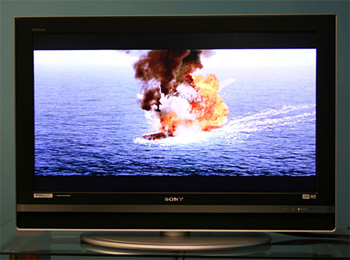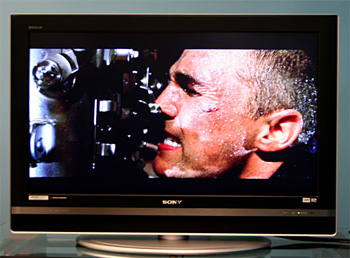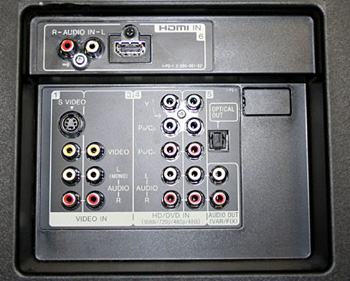Sony XBR LCD TV Review
Model: Sony KDL-V40XBR1 LCD TelevisionDescription: 40 inch diagonal LCD TV; 16:9 Widescreen Format
Resolution: 1366 X 768 (HDTV)
Includes: Remote, Table Top Stand (Swivels 15 degrees, does not tilt), Internal ATSC (high definition) and NTSC tuners
Color: Charcoal black bezel with speakers bottom mounted; silver accent stripe and stand
Dimensions: 40 X 28 ½ X 14 5/8 with stand
40 X 27 X 4 7/8 without stand
Reviewer: Robert Wiley Date: 1-11-2006
INTRODUCTION
Hopefully the KDL-V40XBR1 is a sign of things to come from Sony. The unit has been extremely well received since its debut in the fall of 2005. Sony, after having totally withdrawn from the plasma TV market due to having no control over the production of screens, has soared into the LCD flat screen market with tremendous success. Sony's partnership with Samsung to produce quality competition in the LCD screen arena seems to be going as planned as the company continues to increase market share in the 30" to 40" LCD television sphere.

This Sony XBR LCD TV performs best in bright scenes.
PICTURE: 94/100
Flexible is the best word I can use to express the overall satisfaction I felt for this Sony product's picture performance. Certainly the black levels do not overwhelm and remain, as other best brand LCDs, a noticeable shade lighter than that of good plasma TVs. However, Sony has improved through better pixel technology the viewing angle of this TV, which I calculate as 80 degrees before degradation of color and contrast starts to occur. Long a weakness of LCD, off axis viewing is significantly improved over 2nd tier brands and compare evenly with Sharp's Aquos line.
Brightness levels pop incredibly well on this LCD screen, which helped the Sony to overcome mediocre black level performance and measure a very respectable 985:1 contrast ratio. Dark matter transition was average as there was visible "mapping"/false contouring in dark scenes of U571. I was surprised that the Sony didn't handle dark scenes in film reproduction better.
The allowable picture settings of this LCD TV are well within the boundaries of video test discs, and show no signs of "blooming" with contrast set at peak. I preferred the brightness setting on the LCD scaled back to 48 from the standard setting of 60. There was some edge enhancement distortion starting to occur at above 20% of the Sharpness setting. My preference for Sharpness was 10% across all viewing modes.
Color accuracy testing was difficult to accomplish with test discs across the 4 color temperature ( gray scale) settings of Cool, Neutral, Warm 1, and Warm 2. The Sony was all over the SMPTE standards in color measurements. The measurements varied so much by color temperature setting and aspect ratio setting that there are too many variables to mention. In my opinion the SMPTE standards run too warm and use a pinkish white balance to start with, but to boil it down, reds tend to be over saturated with the Sony 40XBR LCD and can run toward and pinkish or violet-red color. Greens can also be too vivid. Backlighting and contrast also greatly affect the color temp across all testing and I could not find a professional gray scale adjustment menu. There are so many options for color across the various settings and color temperature controls that it is difficult to pin down.
The great news for the owner of this LCD television is that all of these settings and adjustment options give the user loads of flexibility to control their viewing destiny. In fact, for each video input signal, the user may custom set each picture setting option of Vivid, Custom, and Standard. Within those 3 setting are 4 options for color temp and loads of other possibilities for backlighting and picture.
There are 3 component video inputs, an HDMI input, composite, RGB 15 pin and so on—a full offering. Let's say we have DVD, Cable, broadcast HD, video gaming, and camcorder input for our photos and home movies. Within this scenario one has 15 different customized preset picture setting options! And they would all be easily accessible once the initial set up was done (I would say by just a press of a button but Sony makes it cumbersome to get to the picture setting adjustments through the WEGA Gate menu). For instance, with an analog cable input I would program my customizable settings of Vivid for daytime high ambient light situations, Custom for low light nighttime viewing and Standard for somewhere in between. I would repeat this process for all inputs of various resolutions and signal sources. I would further take into consideration the signal resolution of each by using two different inputs from an HD cable or satellite box if possible to take full advantage of these optional picture setting adjustments.
For DVD progressive scan in my dimly lit testing room I came up with the following settings: Warm 1 color temp, Backlight set at 6, picture (contrast) setting maxed out at 100%, brightness set to 47 and sharpness control set to 15.
One should use at least a 480p progressive scanning DVD player with this LCD TV as the 3:2 pull-down filter and de-interlacing technologies are lacking. Colors were much less vibrant in 480i as I found it necessary to increase the backlight and contrast settings. Maybe Sony just did not focus on this area since progressive scan DVD players are the dominant choice today. Stay away from 480i sources or buy an external decoder.
The 40XBR1 internal video engines performed extremely well with all other input sources such as HD from cable, and I was particularly pleased with the picture quality from upconverted analog cable signals. HD pictures were clear, crisp, colorful—everything you expect and with such a range in color options, it's easy to find the perfect flesh tone setting.

The KDL-V40XBR1 delivered excellent pictures from HDTV sources
When viewing an HD version of U571 this LCD's picture was just so clean and crisp and flesh tones were exceptional. The viewing pleasure when watching Matthew McConaughey and company destroy the Nazi destroyer were so vivid that my heart raced as I saw every detail of the torpedo rippled through the water. Through the content that I watched I did not detect a problem with motion lag as I sometimes do with LCD televisions. The 40XBR1 has a response rate time of 9 milliseconds which puts this LCD in the top tier in that category.
OTHER CONSIDERATIONS: 95/100
Aesthetically I would not call the Sony 40XBR1 cutting edge, but instead would pin it with descriptions such as advanced design and very sharp. It has an understated elegance that, while not overwhelming a room, will certainly say "classy" when viewed. As noted above, the LCD TV has 2" charcoal black trim with bottom-mounted speakers and a metallic brushed silver swiveling tabletop stand. The table stand swivels 15 degrees but can be removed in the event one wants to wall mount the TV.
I was very pleased with the 2 X 13 watt speakers, which gave excellent detail and output in my large viewing room. I was amazed by the clarity of output in Sheryl Crow's rendition for the opening song in the 007 flop Tomorrow Never Dies, the true surround feature surprised me as uncannily realistic.
This LCD Television is photo and video USB friendly in the extreme. There are 10 pages in the manual devoted to the photo/video viewer and though I did not test them, they looked thoroughly enjoyable.

This Sony LCD television provides a full complement of inputs
In addition to a side mounted USB port there is a full array of inputs including 3 sets of component video, a 15 pin VGA input for computer, a cable card input, and one HDMI input. This LCD does not have TV Guide on screen menu system (crank up the Tivo). One of my favorite features is a side mounted headphone output jack for those late night family watchers.
The supplied programmable remote control is somewhat universal but is intuitive and easy to use once the viewer understands the WEGA Gate picture setting options. These menu options are trying but once you have customized settings the viewer will not need to go there often. The Wide button on the remote controls a standard complement of aspect ratio scaling settings, normal (4:3), full, Zoom, and Wide Zoom to scale 4:3 content to full screen size. Overall the Sony did a superb job with scaling images.
Value: 93/100
Sony has come out with a winner in the 40" LCD screen size. The 40XBR1 has been a great seller from the start. One reason for this is that it is not priced out of the ballpark—especially given the amount of feature flexibility that it offers. With stellar picture performance with most signals, plenty of inputs, and loads of camera/video options—this LCD TV came to compete in the late fall of 2005 and literally sold out for long periods. At an MSRP price of $3499 there are not many LCDs to compare to it. It's one of the only 40" LCD TVs produced. JVC has a good 40" LCD product for less money. Sharp is less on an inch-by-inch basis but they do not have a 40" offering. The question is, how much extra are you paying for the Sony name, engineering and styling? And what about comparison with plasma pricing and features (see our Plasma TV vs. LCD TV article)? The answer to that question changes with each new offering in this exciting time for televisions. Look for Sony to make a price move on this and other LCD TV models this spring.



